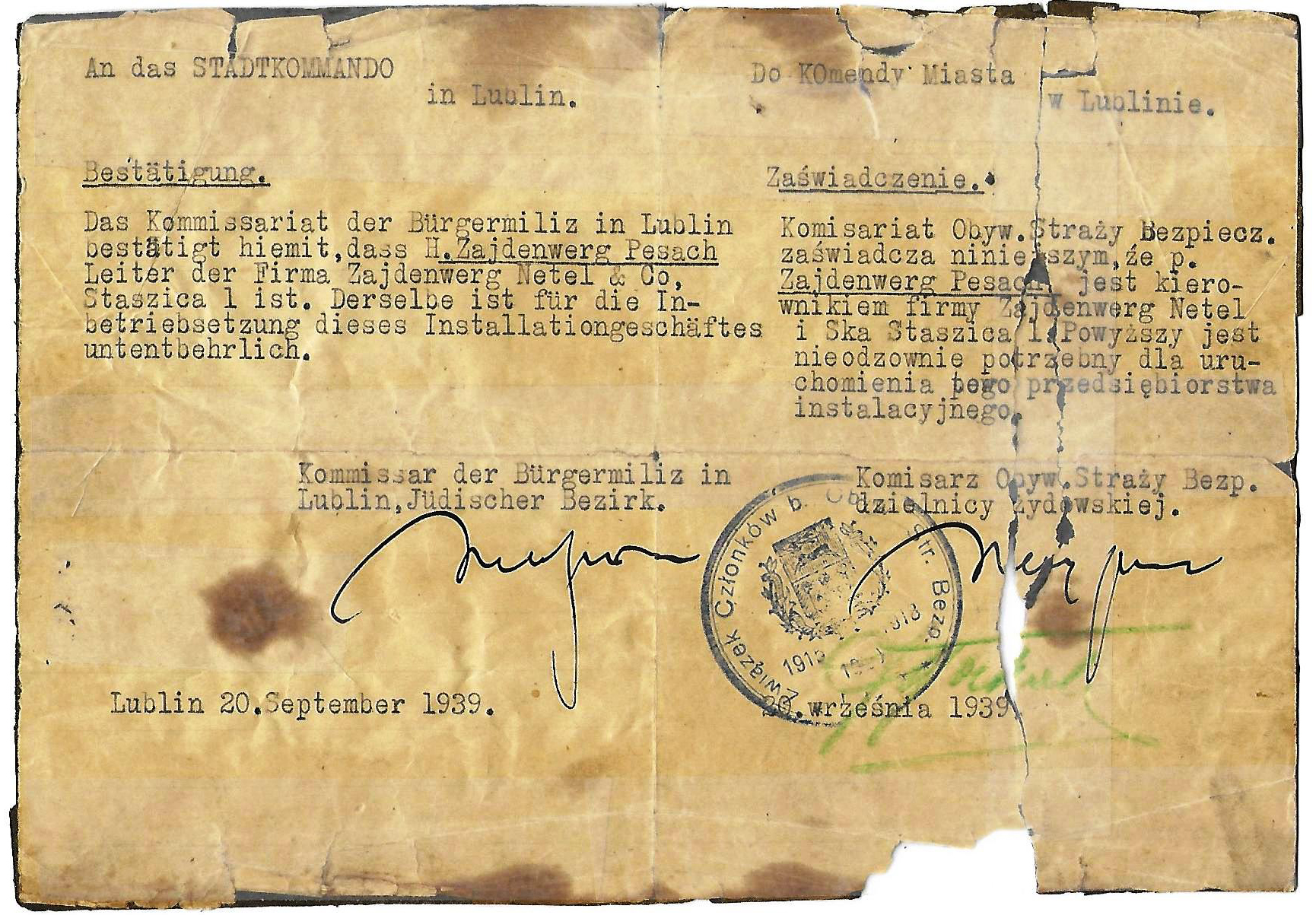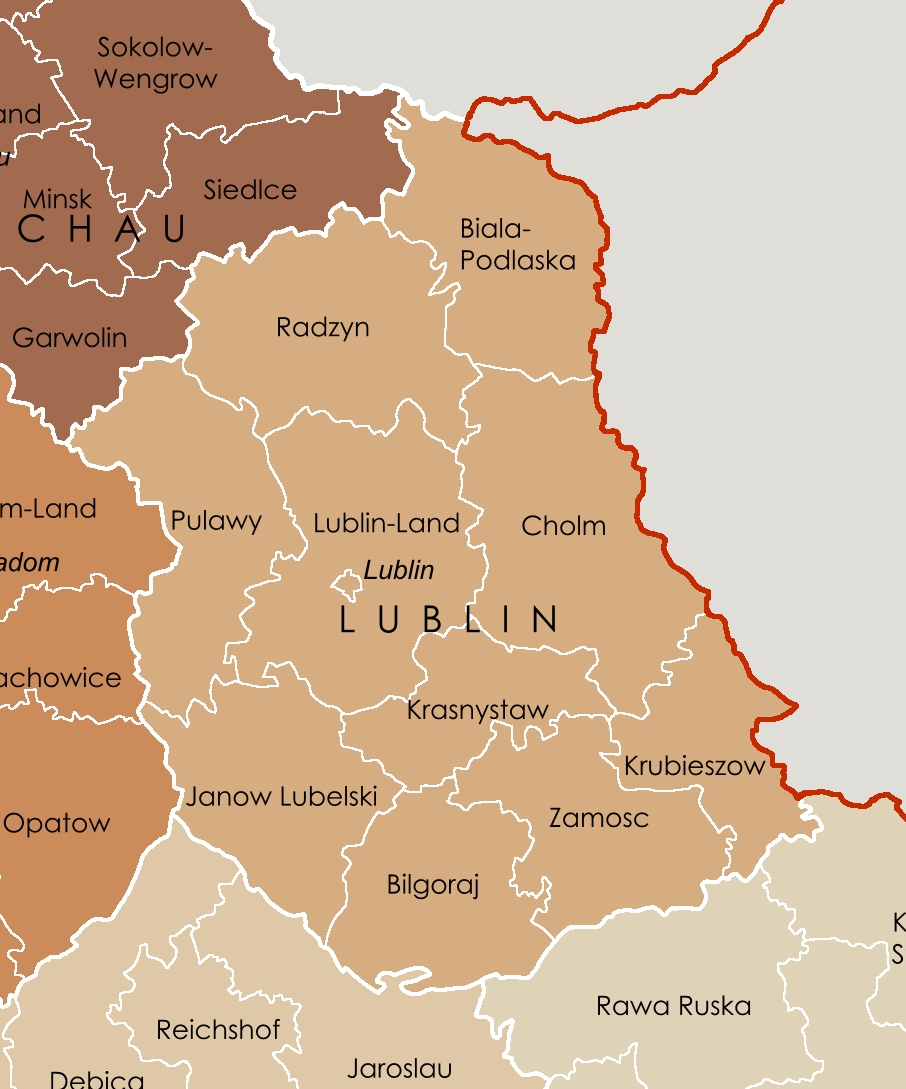|
Lublin Ghetto
The Lublin Ghetto was a World War II ghetto created by Nazi Germany in the city of Lublin on the territory of General Government in occupied Poland. The ghetto inmates were mostly Polish Jews, although a number of Roma were also brought in.Doris L. Bergen ''War & Genocide: A Concise History of the Holocaust'' Rowman & Littlefield, 2002, pg. 144. . Set up in March 1941, the Lublin Ghetto was one of the first Nazi-era ghettos slated for liquidation during the most deadly phase of the Holocaust in occupied Poland.Lawrence N. Powell, ''Troubled Memory: Anne Levy, the Holocaust, and David Duke's Louisiana'', UNC Press, 2002, pg. 12/ref> Between mid-March and mid-April 1942 over 30,000 Jews were delivered to their deaths Holocaust train, in cattle trucks at the Bełżec extermination camp and additional 4,000 at Majdanek.The statistical data compiled on the basis o "Glossary of 2,077 Jewish towns in Poland" by '' Virtual Shtetl'' Museum of the History of the Polish Jews , as ... [...More Info...] [...Related Items...] OR: [Wikipedia] [Google] [Baidu] |
Lublin
Lublin is the ninth-largest city in Poland and the second-largest city of historical Lesser Poland. It is the capital and the center of Lublin Voivodeship with a population of 336,339 (December 2021). Lublin is the largest Polish city east of the Vistula River and is about to the southeast of Warsaw by road. One of the events that greatly contributed to the city's development was the Polish-Lithuanian Union of Krewo in 1385. Lublin thrived as a centre of trade and commerce due to its strategic location on the route between Vilnius and Kraków; the inhabitants had the privilege of free trade in the Grand Duchy of Lithuania. The Lublin Sejm, Parliament session of 1569 led to the creation of a Union of Lublin, real union between the Crown of the Kingdom of Poland and the Grand Duchy of Lithuania, thus creating the Polish–Lithuanian Commonwealth. Lublin witnessed the early stages of Reformation in the 16th century. A Calvinist congregation was founded and groups of radical Ari ... [...More Info...] [...Related Items...] OR: [Wikipedia] [Google] [Baidu] |
Judenrat
A ''Judenrat'' (, "Jewish council") was a World War II administrative agency imposed by Nazi Germany on Jewish communities across occupied Europe, principally within the Nazi ghettos. The Germans required Jews to form a ''Judenrat'' in every community across the occupied territories. The ''Judenrat'' constituted a form of self-enforcing intermediary, used by the Nazi administration to control larger Jewish communities. In some ghettos, such as the Łódź Ghetto, and in Theresienstadt, the Germans called the councils "Jewish Council of Elders" (''Jüdischer Ältestenrat'' or ''Ältestenrat der Juden''). Jewish communities themselves had established councils for self-government as early as the Middle Ages. The Jewish community used the Hebrew term ''Kahal'' (קהל) or ''Kehillah'' (קהילה), whereas the German authorities generally used the term ''Judenräte''. The Judenräte are notorious today for their collaboration with the Nazi regime, almost always under extrem ... [...More Info...] [...Related Items...] OR: [Wikipedia] [Google] [Baidu] |
Polish Zloty
Polish may refer to: * Anything from or related to Poland, a country in Europe * Polish language * Poles, people from Poland or of Polish descent * Polish chicken * Polish brothers (Mark Polish and Michael Polish, born 1970), American twin screenwriters Polish may refer to: * Polishing, the process of creating a smooth and shiny surface by rubbing or chemical action ** French polishing, polishing wood to a high gloss finish * Nail polish * Shoe polish * Polish (screenwriting), improving a script in smaller ways than in a rewrite See also * * * Polonaise (other) A polonaise ()) is a stately dance of Polish origin or a piece of music for this dance. Polonaise may also refer to: * Polonaises (Chopin), compositions by Frédéric Chopin ** Polonaise in A-flat major, Op. 53 (french: Polonaise héroïque, ... {{Disambiguation, surname Language and nationality disambiguation pages ... [...More Info...] [...Related Items...] OR: [Wikipedia] [Google] [Baidu] |
Gestapo
The (), abbreviated Gestapo (; ), was the official secret police of Nazi Germany and in German-occupied Europe. The force was created by Hermann Göring in 1933 by combining the various political police agencies of Prussia into one organisation. On 20 April 1934, oversight of the Gestapo passed to the head of the '' Schutzstaffel'' (SS), Heinrich Himmler, who was also appointed Chief of German Police by Hitler in 1936. Instead of being exclusively a Prussian state agency, the Gestapo became a national one as a sub-office of the (SiPo; Security Police). From 27 September 1939, it was administered by the Reich Security Main Office (RSHA). It became known as (Dept) 4 of the RSHA and was considered a sister organisation to the (SD; Security Service). During World War II, the Gestapo played a key role in the Holocaust. After the war ended, the Gestapo was declared a criminal organisation by the International Military Tribunal (IMT) at the Nuremberg trials. History Af ... [...More Info...] [...Related Items...] OR: [Wikipedia] [Google] [Baidu] |
Jewish Resistance Under Nazi Rule
Jewish resistance under Nazi rule took various forms of organized underground activities conducted against German occupation regimes in Europe by Jews during World War II. According to historian Yehuda Bauer, Jewish resistance was defined as actions that were taken against all laws and actions acted by Germans. The term is particularly connected with the Holocaust and includes a multitude of different social responses by those oppressed, as well as both passive and armed resistance conducted by Jews themselves. Due to military strength of Nazi Germany and its allies, as well as the administrative system of ghettoization and the hostility of various sections of the civilian population, few Jews were able to effectively resist the Final Solution militarily. Nevertheless, there are many cases of attempts at resistance in one form or another including over a hundred armed Jewish uprisings. [...More Info...] [...Related Items...] OR: [Wikipedia] [Google] [Baidu] |
Lublin Castle
The Lublin Castle ( pl, Zamek Lubelski) is a medieval castle in Lublin, Poland, adjacent to the Old Town district and close to the city center. It is one of the oldest preserved royal residencies in Poland, initially established by High Duke Casimir II the Just. Its contemporary Gothic Revival appearance is largely due to a reconstruction undertaken in the 19th century. History The hill it is on was first fortified with a wood-reinforced earthen wall in the 12th century. In the first half of the 13th century, the stone keep was built. It still survives and is the tallest building of the castle, as well as the oldest standing building in the city. In the 14th century, during the reign of Casimir the Great, the castle was rebuilt with stone walls. Probably at the same time, the castle's Chapel of the Holy Trinity was built as a royal chapel. In the first decades of the 15th century, King Władysław II commissioned a set of frescoes for the chapel. They were completed in 1418 an ... [...More Info...] [...Related Items...] OR: [Wikipedia] [Google] [Baidu] |
General Jewish Labour Bund In Poland
The General Jewish Labour Bund in Poland ( yi, אַלגעמײַנער ײדישער אַרבעטער בּונד אין פוילן, translit=Algemeyner Yidisher Arbeter-bund in Poyln, pl, Ogólno-Żydowski Związek Robotniczy "Bund" w Polsce) was a Jewish socialist party in Poland which promoted the political, cultural and social autonomy of Jewish workers, sought to combat antisemitism and was generally opposed to Zionism. Creation of the Polish Bund The Polish Bund emerged from the General Jewish Labour Bund in Lithuania, Poland and Russia of the erstwhile Russian empire. The Bund had party structures established amongst the Jewish communities in the Polish areas of the Russian empire. When Poland fell under German occupation in 1914, contact between the Bundists in Poland and the party centre in St. Petersburg became difficult. In November 1914 the Bund Central Committee appointed a separate Committee of Bund Organizations in Poland to run the party in Poland. Theoreticall ... [...More Info...] [...Related Items...] OR: [Wikipedia] [Google] [Baidu] |
Lublin District
Lublin District (german: Distrikt Lublin) was one of the first four Nazi districts of the General Governorate region of German-occupied Poland during World War II, along with Warsaw District, Radom District, and Kraków District. On the south and east, it initially bordered the Soviet Union. After Operation Barbarossa, it bordered Reichskommissariat Ukraine to the east and Galizien District The District of Galicia (german: Distrikt Galizien, pl, Dystrykt Galicja, ua, Дистрикт Галичина) was a World War II administrative unit of the General Government created by Nazi Germany on 1 August 1941 after the start of O ... to the south, which was also part of the General Governorate. References * General Government History of Lublin Voivodeship {{Poland-history-stub ... [...More Info...] [...Related Items...] OR: [Wikipedia] [Google] [Baidu] |
Operation Barbarossa
Operation Barbarossa (german: link=no, Unternehmen Barbarossa; ) was the invasion of the Soviet Union by Nazi Germany and many of its Axis allies, starting on Sunday, 22 June 1941, during the Second World War. The operation, code-named after Frederick Barbarossa ("red beard"), a 12th-century Holy Roman emperor and German king, put into action Nazi Germany's ideological goal of conquering the western Soviet Union to repopulate it with Germans. The German aimed to use some of the conquered people as forced labour for the Axis war effort while acquiring the oil reserves of the Caucasus as well as the agricultural resources of various Soviet territories. Their ultimate goal was to create more (living space) for Germany, and the eventual extermination of the indigenous Slavic peoples by mass deportation to Siberia, Germanisation, enslavement, and genocide. In the two years leading up to the invasion, Nazi Germany and the Soviet Union signed political and economic pacts fo ... [...More Info...] [...Related Items...] OR: [Wikipedia] [Google] [Baidu] |
Wehrmacht
The ''Wehrmacht'' (, ) were the unified armed forces of Nazi Germany from 1935 to 1945. It consisted of the ''Heer'' (army), the ''Kriegsmarine'' (navy) and the ''Luftwaffe'' (air force). The designation "''Wehrmacht''" replaced the previously used term and was the manifestation of the Nazi regime's efforts to rearm Germany to a greater extent than the Treaty of Versailles permitted. After the Nazi rise to power in 1933, one of Adolf Hitler's most overt and audacious moves was to establish the ''Wehrmacht'', a modern offensively-capable armed force, fulfilling the Nazi régime's long-term goals of regaining lost territory as well as gaining new territory and dominating its neighbours. This required the reinstatement of conscription and massive investment and defense spending on the arms industry. The ''Wehrmacht'' formed the heart of Germany's politico-military power. In the early part of the Second World War, the ''Wehrmacht'' employed combined arms tactics (close- ... [...More Info...] [...Related Items...] OR: [Wikipedia] [Google] [Baidu] |






.jpg)